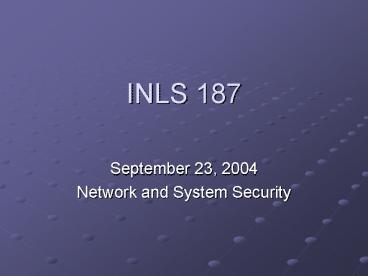INLS 187 - PowerPoint PPT Presentation
1 / 16
Title:
INLS 187
Description:
In the early days, 'UNIX' and 'security' were a contradiction in terms ... sometimes necessary, but can create gaping security holes (remember, root can do ... – PowerPoint PPT presentation
Number of Views:98
Avg rating:3.0/5.0
Title: INLS 187
1
INLS 187
- September 23, 2004
- Network and System Security
2
UNIX System Security
- In the early days, UNIX and security were a
contradiction in terms - Original system had plaintext passwords only, no
concept of separate users, groups, etc. - NIX security has come a long way to arrive at
what you see today - Along the way, companies often shipped systems
wide open and you were supposed to lock them down
as you saw fitcontrast with today
3
Basic concepts
- Two basic ways of preventing security problems in
UNIX - Passwordsdesigned to prevent unauthorized access
- File permissionsallow access control over users
on the system - Root, or superuser account has complete access
4
More basic concepts
- /etc/passwd is the UNIX password fileworld
readable - /etc/shadow holds shadow passwordsonly
readable by root - The concept of groups was soon added to solve
workgroup-related access control problems - /etc/group
5
System logins
- In a big enough environment, logins may be
handles centrally using NIS (yellowpages), AFS,
Kerberos, or another system
6
File and directory permissions
- Symbolic file access modes
- ls l command reveals file access information
- Three operationsreading, writing, executing
- Three tiers of privilegeowner, group, and other
- Nine slots 1 (called the mode)
7
Useful features of ls
- Not only can ls show you the access rights, it
can also show you - Owner
- Group
- Creation timestampactually, denotes last
change to inode (ctime) - Last modification timestamp (mtime)
- Last access timestamp (atime)
8
Setting permissions
- ls command also reveals owner group
- chmod or change mode command allows you to set
or change file/directory permissions - -rwxrxwrxw
- drwxrwxrwx
- srwxrwxrwx
9
Setting permissions
- Two ways to do this
- Use the alpha charactes
- Octal notation
10
Changing owner or group
- Other commands allow you to change the owner,
group, or both - chown
- chgrp
- chown usergroup
11
File mode
- Denotes a directory
- Denotes special files such as block special or
character special files (not really
security-related, so read about these offline) - Also can denote suid root filesfiles that if
run, run as root - Suid is sometimes necessary, but can create
gaping security holes (remember, root can do
anything and by setting the sticky bit, you are
handing over the keys to the castle in a sense)
12
Sticky bit
- If a user has file write permission on a
directory, they can rename or remove any files
underneath - This can be prevented by setting the sticky bit
on the directory - Chmod 1777 test
13
Other useful tools
- ps command view running processes
- who
- last
- uptime
- netstat
- setting the umask
14
Okay, now Windows
- Windows security is now very similar to that of
UNIX - Concept of users and groups exists
- All GUI based, however
- Windows password file is very cryptic and
obscure, but not really any more secure
15
Windows Logins
- Using active directory or netbios, users can
login to multiple different workstations - Can also substitute AFS or Kerberos to achieve
the same things - UNC GINA
- Novell Netware
16
File access in Windows
- Demonstrate































